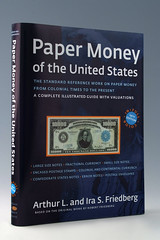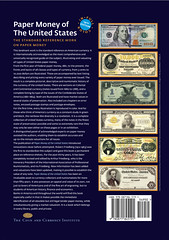
PREV ARTICLE
NEXT ARTICLE
FULL ISSUE
PREV FULL ISSUE
In recent issues we discussed the numismatic books and other products of The Coin and Currency Institute, Inc. This week the firm issued a press release announcing the latest edition of their flagship book, Friedberg's "Paper Money of United States".
-Editor
Fifty-seven years after its introduction, the nineteenth edition of Paper Money of United States, the standard reference book on United States paper money is being released by The Coin & Currency Institute of Clifton, New Jersey. In 1953, the late Robert Friedberg (1912-1963) broke new ground when the Treasury Department granted permission for photographs of American paper money to be printed for the first time. The current edition's 328 pages sets the standard once again by featuring notes from America's greatest currency collections, all reproduced in color. The inaugural edition of Paper Money of the United States also introduced other innovations never before attempted. The subject became standardized and the book earned a permanent place on reference shelves. During the past three decades, it has been completely expanded, revised, and edited by Ira S. Friedberg and Arthur L. Friedberg, who has been recognized by the International Association of Professional Numismatists with its highest honor, the title of Honorary President.
There are over twenty new catalog numbers assigned to the Legal Tender Notes of 1862-1863 to more accurately reflect differences among the various issues and their rarity. An increasingly popular area of collecting, “paper money mules” are included for the first time. The term “mule” refers to the plate numbers that appear in small digits on the front and back of every note. Mulings occurred when printing plates got mixed up and were used in a sequence which would appear to be inconsistent. They exist for both large size and small size currency and mules are indicated with a letter “m” and priced accordingly in the book's text. An entirely new section is devoted to Postage Envelopes, another form of emergency currency along with Fractional Currency and Encased Postage Stamps, created to alleviate the shortage of change needed for commerce during the Civil War. The listing in the Appendix of the 14,348 National Banks that existed from 1863 to 1929 has been redone, as well, now showing the numbers of large size and small size notes known to exist for each note-issuing bank. From the first year of Federal paper money, 1861, to the present, the fronts and backs of all classes and types of currency, from 3 cents to 10,000 dollars are illustrated. These are accompanied by text listing, describing and pricing every variety of paper money ever issued, more than 10,000 prices in all. With close to 1,000 color photographs, the result is a complete pictorial, descriptive and numismatic history of the currency of the United States. There are also supplemental sections on Colonial and Continental Currency (notes issued from 1680 to 1788), the Treasury Notes of the War of 1812, considered by some to be the first national currency, a comprehensive listing by type of the issues of the Confederate States of America, and a section devoted to paper money errors. Paper money collectors depend on the Friedberg Numbering System, a uniform method of cataloging bank notes that is the international standard for American currency. This numbering shorthand, along with the hundreds of photographs, enables anyone to instantly locate a specific banknote, and allows a dealer to advertise a note without need of extensive description. A distinguished panel of acknowledged experts on paper money has assisted the authors, enabling them to establish accurate and up-to-the minute valuations for all issues. Paper Money of the United States has been an invaluable asset to currency collectors and numismatists for over half a century. It possesses an appeal and value of its own, not just to lovers of Americana and of the fine art of engraving, but to students of American history, finance and economics. It is recognized as a landmark work and is the undisputed standard reference on American currency – internationally acknowledged as the most comprehensive and universally quoted guide on the subject. Banks in America and throughout the world will find this book especially useful in that it makes possible the immediate identification of all obsolete but still legal tender paper money, while simultaneously giving the collector's value of each note. It is a book which belongs in every library, public and private. Sample pages from the 19th edition may be seen on the book's website, www.PaperMoneyoftheUS.com . The book's list price is $49.50 and it is available from book stores, coin and paper money dealers, and from internet book sellers (ISBN 978-087184-519-1). Copies may also be obtained by mail from The Coin & Currency Institute, P.O. Box 1057, Clifton, N.J. 07014. A version of the book on CD-ROM (ISBN 978-087184-909-0) costs $36.50. $5.50 should be added to each order for shipping and handling. Major credit cards are accepted. Call toll-free 1-888-471-1441. Fax (973) 471-1062. E-mail: info@PaperMoneyoftheUS.com. In Europe, contact Spink & Son, Ltd., London. Most of the book's illustrations are from the Aubrey and Adeline Bebee Collection of United States Paper Money at the American Numismatic Association in Colorado Springs, Colorado. In recognition of this, a specially-bound, serially numbered (1-200) and autographed edition of the book was scheduled to be available at the Annual Convention of American Numismatic Association in Boston, MA from August 10-14 where highlights of the Bebee Collection were to be on display. Proceeds will benefit the A.N.A. Edward C. Rochette Money Museum.
The web site appears to be out of date, though - it describes the 18th edition.
E-Sylum readers may remember that John Nebel took magnificent ultra-high resolution photos of the ANA's Bebee collection. I assumed these were the images used in the book, and wondered if they were properly credited. -Editor John writes: I gave a copy of 600dpi Bebee images to Doug Mudd and I hope he passed those on to Arthur, I'd hope they didn't repeat the work done 10 years ago. The original Bebee note scans are 2540dpi and allow the notes to be printed 50" wide on photographic paper without any loss of sharpness. A couple of those photographic prints are on display in the ANA library. It was a major project to scan and store the note images with the computer equipment available in 2000, but it was worth it because it is a wonderful collection of beautiful banknotes. Today, one would have to pay $20,000 for a Kodak scanner not quite as good as the one used for the Bebee notes. I be embarrassed to say what the project cost in its entirety. The notes can be viewed on-line at http://ana-museum.org/. Motivated by a question Scott Rottinghaus asked, programs were developed for the web site which allow clicking on any part of the images to view details in a pop-up window. To make the pop-ups efficient, the banknote images were sliced into about 3.4 million squares, 64 of which are loaded on a mouse click.
To read the earlier E-Sylum article, see:
ANA DEBUTS ONLINE BEBEE PAPER MONEY COLLECTION EXHIBIT
(www.coinbooks.org/esylum_v12n44a06.html)
The Numismatic Bibliomania Society is a non-profit organization promoting numismatic literature. See our web site at coinbooks.org. To submit items for publication in The E-Sylum, write to the Editor at this address: whomren@gmail.com To subscribe go to: https://my.binhost.com/lists/listinfo/esylum All Rights Reserved. NBS Home Page Contact the NBS webmaster 
|

